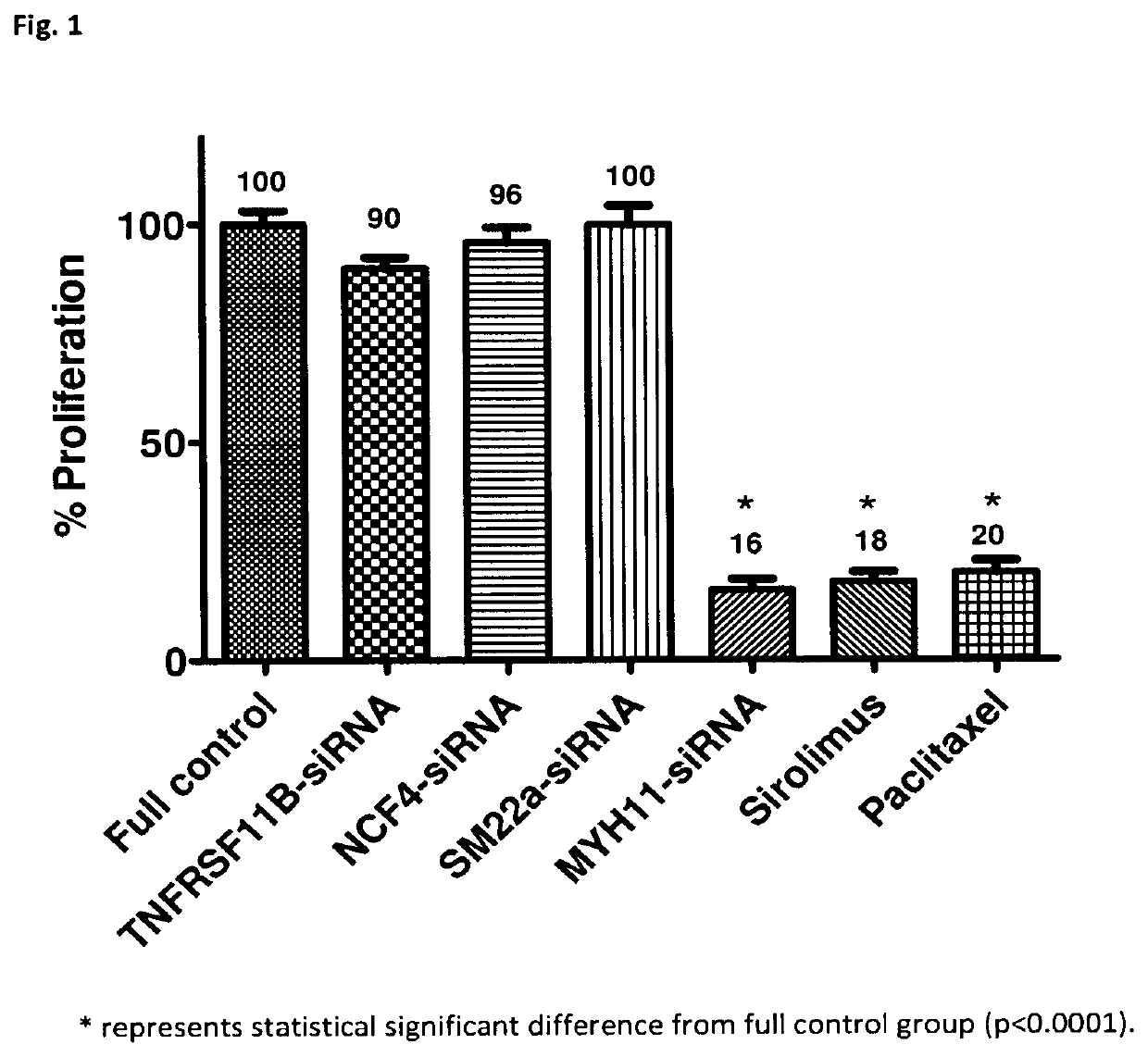Device and method for promoting rapid strut coverage and vascular endothelial coverage
a technology of vascular endothelial and strut, which is applied in the field of medical devices, can solve the problems of increasing the rate of stent thrombosis, affecting the re-endothelialization speed of stent, so as to facilitate the permanent patency of the blood vessel and early re-endothelialization
- Summary
- Abstract
- Description
- Claims
- Application Information
AI Technical Summary
Benefits of technology
Problems solved by technology
Method used
Image
Examples
experiment 1
[0078]Out of 27 patients who underwent directional atherectomy with the Flexicut (Guidant, USA) catheter to withdraw fragments of ISR plaques and de novo coronary artery plaques, 12 patients had ISR and 15 patients had symptomatic de novo coronary artery lesions. The atherectomy samples (plaques) were identified, placed in RNA Stat 60 and stored in liquid nitrogen until gene profiling analysis of more than 22,000 genes. RNA was isolated from atherectomy samples by homogenization with a PowerGen model 125 homogenizer (Thermo Fisher Scientific, USA), followed by extraction with 0.2 volume of chloroform, precipitation with 0.5 volume of isopropanol, wash in 75% ethanol, and suspension in RNase-free water. RNA concentration was measured by use of the NanoDrop spectrophotometer (Thermo Fisher Scientific, USA). RNA quality and purity were assessed by the RNA 6000 pico or nano assay using Agilent 2100 Bioanalyzer (Agilent Technologies, USA).
[0079]Samples were labelled for gene expression p...
experiment 2
[0084]After identifying 2 genes with a high potential for modulating the inflammatory response that causes ISR in Experiment 1, the therapeutic response was assessed by neutralizing said 2 genes (TNFRSF11B & NCF4) in bottles containing human VSMC or human vascular EC by means of gene silencers which are a specific interfering RNA sequence that block the protein translation of a specific gene; in this case, that of the NFRSF11B and NCF4 genes.
[0085]Therefore, Experiment 2 was carried out with the following groups: lentivirus+gene silencer TNFRSF11B-siRNA, lentivirus+gene silencer NCF4-siRNA, full control (no vehicle and no drug), lentivirus+gene silencer SM22a-siRNA+glyceraldehyde 3-phosphate dehydrogenase (GAPDH) (vehicle control 1), lentivirus+gene silencer MYH11-siRNA+GAPDH (vehicle control 2), sirolimus (drug control 1), and paclitaxel (drug control 2).
[0086]TNFRSF11B-siRNA and NCF4-siRNA are gene silencers of the TNFRSF11B and NCF4 genes, respectively. The delivery system of gen...
experiment 3
[0095]In Experiment 2, the 2 gene silencers identified in Experiment 1—TNFRSF11B-siRNA and NCF4-siRNA—did not show the expected benefits while one of the two gene silencers used as a control of the lentivirus vehicle—MYH11-siRNA—showed what was expected from the TNFRSF11B-siRNA and NCF4-siRNA, that is, significant inhibition of VSMC proliferation and non-significant inhibition of EC proliferation.
[0096]Therefore, even though the probability of error when identifying bottles or replacing gene silencers while preparing the suspensions was low as a result of the team's careful work and experience, it was decided to partially repeat Experiment 2 to confirm the results obtained in relation to the MYH11-siRNA.
[0097]Thus, Experiment 3 consisted of the following groups: lentivirus+gene silencer MYH11-siRNA, lentivirus+gene silencer TNFRSF11BsiRNA, and lentivirus+gene silencer NCF4-siRNA.
[0098]The results of the bottles containing human VSMC and human vascular EC are shown in FIGS. 3 and 4, ...
PUM
| Property | Measurement | Unit |
|---|---|---|
| concentration | aaaaa | aaaaa |
| volume | aaaaa | aaaaa |
| concentrations | aaaaa | aaaaa |
Abstract
Description
Claims
Application Information
 Login to View More
Login to View More - R&D
- Intellectual Property
- Life Sciences
- Materials
- Tech Scout
- Unparalleled Data Quality
- Higher Quality Content
- 60% Fewer Hallucinations
Browse by: Latest US Patents, China's latest patents, Technical Efficacy Thesaurus, Application Domain, Technology Topic, Popular Technical Reports.
© 2025 PatSnap. All rights reserved.Legal|Privacy policy|Modern Slavery Act Transparency Statement|Sitemap|About US| Contact US: help@patsnap.com



